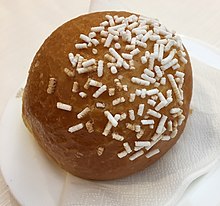 | |
| Type | Dessert |
|---|---|
| Place of origin | Italy |
| Region or state | Milan |
| Main ingredients | Flour, butter, sugar |
| Variations | Big verson with candied fruits, small version can be filled with custard; covered with plain sugar or icing |
Veneziana is a sweet of the Lombard cuisine covered with sugar grains or almond icing.[1] It is served in two versions: the bigger one is consumed during Christmas,[2] like panettone; the smaller one is eaten as breakfast, along with cappuccino, like croissants. Veneziana is butter and flour-based and uses sourdough as leavening;[3] the smaller version is usually plain, sometimes filled with custard, while the bigger version contains candied orange.
The history of veneziana is very similar to that of the panettone, which was created around XV century.[4] This sweet was once eaten during celebrations like weddings and Christmas, while since the end of Second World War is considered a breakfast food. Buondì, a popular snack in Italy, is the industrial version of veneziana.
See also
[edit]References
[edit]- ^ "Veneziana, the Yummy Alternative to Panettone". La Cucina Italiana. 2020-12-30. Retrieved 2021-11-14.
- ^ "Patrimonio culinario Svizzero Patrimoine culinaire". www.patrimoineculinaire.ch. Retrieved 2021-11-14.
- ^ "Milano, la preparazione della veneziana: è il dolce di Capodanno". la Repubblica (in Italian). 2016-12-29. Retrieved 2021-11-14.
- ^ "A Culinary History of Panettone, the Italian and South American Christmas Treat". Smithsonian Magazine. Retrieved 2021-11-14.
Well, that’s interesting to know that Psilotum nudum are known as whisk ferns. Psilotum nudum is the commoner species of the two. While the P. flaccidum is a rare species and is found in the tropical islands. Both the species are usually epiphytic in habit and grow upon tree ferns. These species may also be terrestrial and grow in humus or in the crevices of the rocks.
View the detailed Guide of Psilotum nudum: Detailed Study Of Psilotum Nudum (Whisk Fern), Classification, Anatomy, Reproduction